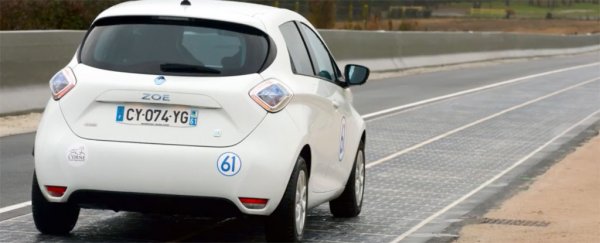French officials have opened the world's first solar road in the region of Normandy, unveiling a 1-kilometre-long (0.6-mile-long) route covered in 2,880 photovoltaic panels.
The trial roadway, called Wattway, passes through the small town of Tourouvre-au-Perche. It's expected to be used by approximately 2,000 motorists daily during a two-year test period, to see just how much electricity it can generate.
The project was financed by the French Ministry of the Environment and built by engineering firm Colas, and initial estimates of the power output suggest the Wattway will generate more than enough electricity to run all of Tourouvre-au-Perche's street lights.
The Wattway is projected to produce 280 megawatt hours (MWh) of energy annually, with an estimated electrical output of 767 kilowatt hours (kWh) per day.
The Ministry of the Environment says that's enough to provide public lighting for a population of 5,000, so provided the weather cooperates, Tourouvre-au-Perche's 3,400 residents should have their nights lit up by the Sun from now on (if you know what we mean).
But while the accomplishment may be unprecedented, critics say the cost of building the Wattway at €5 million (about US$5.2 million) doesn't add up, pointing out that the energy produced by the solar road costs 13 times as much as building rooftop panels.
Part of this is attributable to the Wattway's unique construction, which has been engineered to withstand being driven over repeatedly by cars and large trucks. The panels are covered with a resin containing sheets of silicon, so they can survive heavy traffic.
By contrast, similar solar panel projects, like a bike path that opened in the Netherlands in 2014, only have to be durable enough to support the weight and friction of cyclists.
Colas wants to get the cost of producing the panels down to make it competitive, which would fit France's goal of installing 1,000 kilometres (621 miles) of solar-panelled roads in the next four years or so.
Whether that's going to happen or not will depend on how well this two-year trial goes, and if the costs do come down, then it's definitely something worth aiming for: 1,000 kilometres of solar roads would provide electricity to around 5 million people – about 8 percent of France's population.
That's a big 'if' though, as photovoltaic specialists have said in the past that solar road concepts aren't ultimately as practical as solar rooftop panelling, as the inclined angle of rooftops makes them better positioned to catch the rays of the Sun.
So, there's a lot riding on this trial, and not just for France, but also other countries – as Colas has plans to test similar sites internationally in 2017 at around 100 locations.
For now, though, all eyes are on the little village of Tourouvre-au-Perche, to see if those solar roads can deliver on their promise.
Watch this space.
